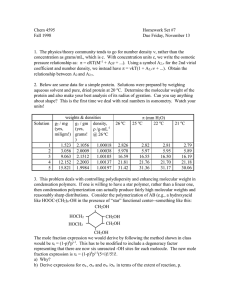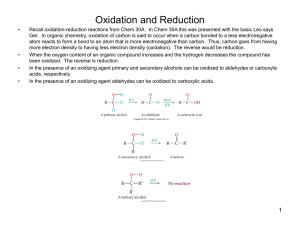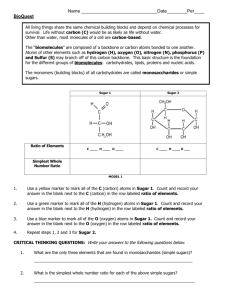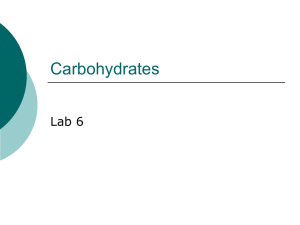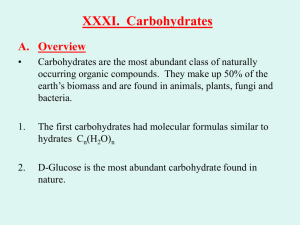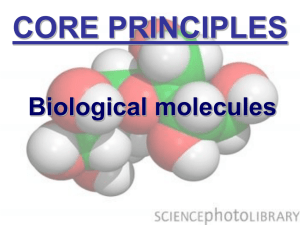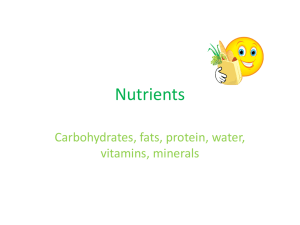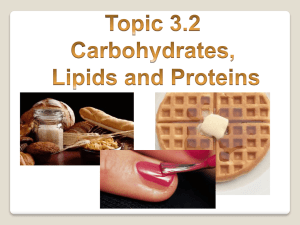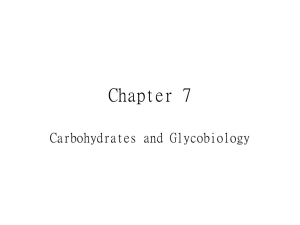Chapter 4 The Carbohydrates: Sugars, Starches, and Fibers
advertisement
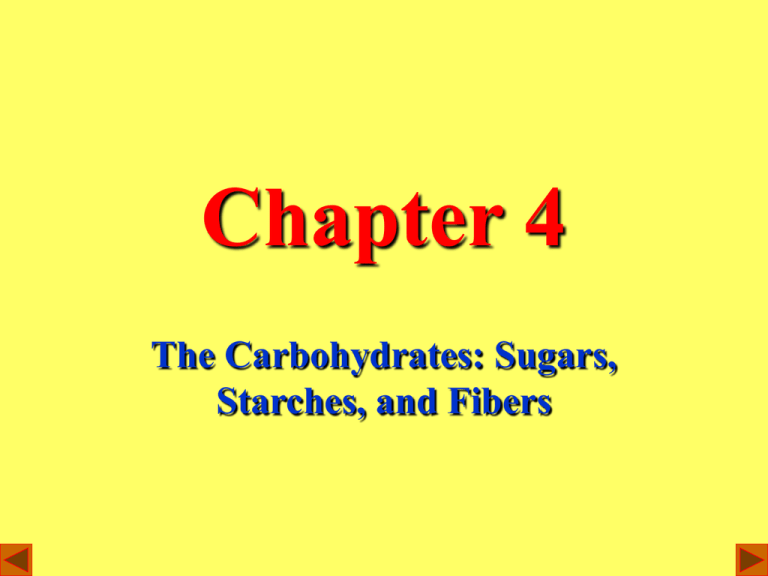
Chapter 4 The Carbohydrates: Sugars, Starches, and Fibers O N C Oxygen Nitrogen Carbon H Hydrogen H H H N C C O H H C C O H H H Ethanol H H H H H Ethanolamine Carbohydrates most abundant class of compounds found in nature contain the elements C, H and O term “CARBOHYDRATES” came from fact that these compounds could be written as “hydrates of carbon” e.g. C6H12O6 = C6(H2O)6 Simple Carbohydrates (sugars) Monosaccharides CH2OH O OH H H OH H H HO H OH Glucose Simple Carbohydrates (sugars) Monosaccharides CH2OH O OH H H OH H H HO H OH Glucose CH2OH O OH HO H OH H H H H OH Galactose Simple Carbohydrates (sugars) Monosaccharides HOH2C O CH2OH H HO H OH OH H Fructose Simple Carbohydrates (sugars) Disaccharides Maltose CH2OH CH2OH O H H O OH H H H OH H OH H HO H O H OH H OH Simple Carbohydrates (sugars) Disaccharides Maltose CH2OH CH2OH O H H O OH H H H OH H OH H HO H O H OH H OH Glucose Glucose -glycosidic bond Simple Carbohydrates (sugars) Disaccharides CH2OH CH2OH O H H O OH H H H OH H OH H HO H O H OH H OH Hydrolysis 2 CH2OH O OH H H OH H H HO H OH Glucose Simple Carbohydrates (sugars) Disaccharides Sucrose CH2OH O H H H OH H HO H OH glycosidic bond O HOH2C H Glucose O HO CH2OH H OH H Fructose Simple Carbohydrates (sugars) Disaccharides Lactose CH2OH O HO H OH H H H OH H Galactose CH2OH O H H H Glucose H OH O OH OH H -glycosidic bond Complex Carbohydrates Polysaccharides (glycogen, starches & fibres) Glycogen – energy storage in animals Starches – energy storage in plants Fibres – provides structure in plants Complex Carbohydrates (glycogen versus starches) O O O O O O O O O O O O O O O O O O O O O Animals Glycogen Plants Starch (amylopectin) and (amylose) Hydrolysis (breakdown) of Complex Carbohydrates Both glycogen and starches can be broken down by the human digestive system to give || Glucose ©2001 Brooks/Cole, a division of Thomson Learning, Inc. Thomson Learning ™ is a trademark used herein under license. Major sources of starch include grains, legumes, and tubers. Starches O O O O O O O O O O O O O O O O O O O O Cellulose O O O O O O O O O O Starch and cellulose molecules compared (small segments) Starch digestion in the GI Tract MOUTH: Starches are hydrolysed to smaller and smaller polysaccharides by enzymes referred to as AMYLASE. STOMACH: AMYLASE is deactivated due to acidic pH. SMALL INTESTINE: Pancreatic AMYLASE break starch polysaccharides down more and DISACCHARIDASES break down disaccharides. Fiber in the GI Tract MOUTH: Fibers are mechanically ripped apart by teeth and moistened. NO ENZYME BREAKDOWN STOMACH and SMALL INTESTINE: NO ENZYME BREAKDOWN LARGE INTESTINE: Bacterial enzymes can break down small amounts of fiber…. FERMENTATION…. CAUSES GAS Absorption of Monosaccharides Monosaccharides enter directly into the blood capillaries Converted to GLUCOSE Glucose and Galactose are moved across cell membranes by ACTIVE TRANSPORT Fructose moves across my FACILITATED DIFFUSION The carbohydrates of grains, vegetables, fruits and legumes supply most of the energy in a healthful diet. ©2001 Brooks/Cole, a division of Thomson Learning, Inc. Thomson Learning ™ is a trademark used herein under license. Maintaining blood glucose homeostasis Diabetes - related to the function of insulin to regulate glucose levels Type I (juvenile diabetes) Type 2 (adult diabetes) ©2001 Brooks/Cole, a division of Thomson Learning, Inc. Thomson Learning ™ is a trademark used herein under license. Foods rich in starch and fiber offer many health benefits. ©2001 Brooks/Cole, a division of Thomson Learning, Inc. Thomson Learning™ is a trademark used herein under license. Carbohydrates on Food Labels Structure of Artificial Sweeteners O NH SO3H C NH Cyclamate (30 X) S O Saccharin (450 X) O H N C H O O O CH 3 NH2 O OH Aspartame (180 X) Hydrolysis of Aspartame H NH2 O N OH C H O O O CH 3 H NH2 N H C H O OH phenylalanine HO OH O CH3OH methanol O aspartic acid Sucralose (600 X) Sucrose CH2OH O H H H OH H HO Glucose H OH CH2OH O H Cl H OH H O O HOH2C Fructose Cl O H HO CH2OH H OH H H OH CH2 O H HO CH2 Cl H OH H H C O H C OH HO C H H C OH CH2OH Sugar Replacers xylose H H C OH H C OH HO C H H C OH CH2OH xylitol H H C O C O H C OH HO C H HO C H HO C H H C OH H C OH H C OH H C OH CH2OH CH2OH glucose mannose H H H C OH H C OH HO C H H C OH HO C H HO C H H C OH H C OH H C OH H C OH CH2OH CH2OH sorbitol mannitol ©2001 Brooks/Cole, a division of Thomson Learning, Inc. Thomson Learning ™ is a trademark used herein under license. Dental Caries (cavities)
